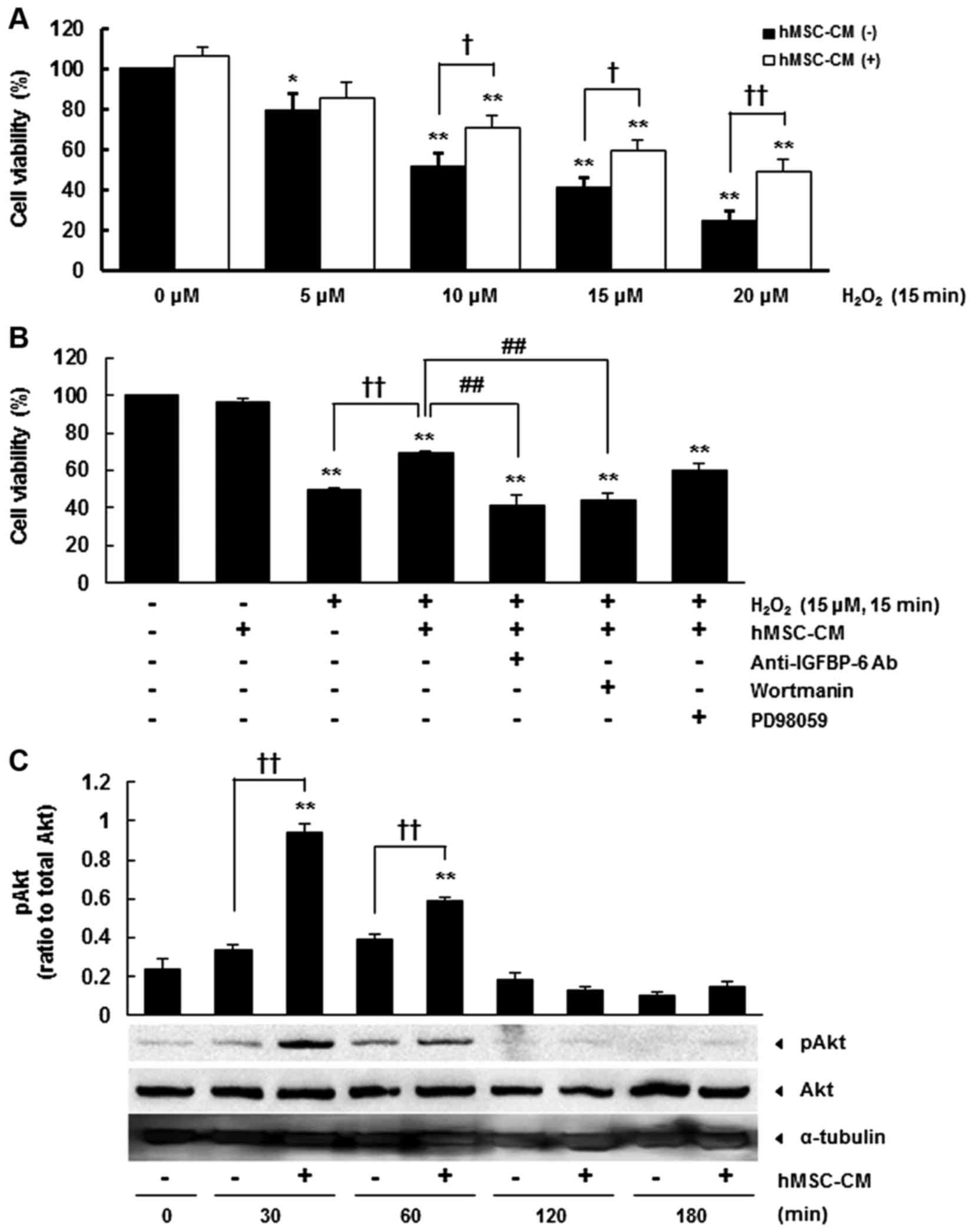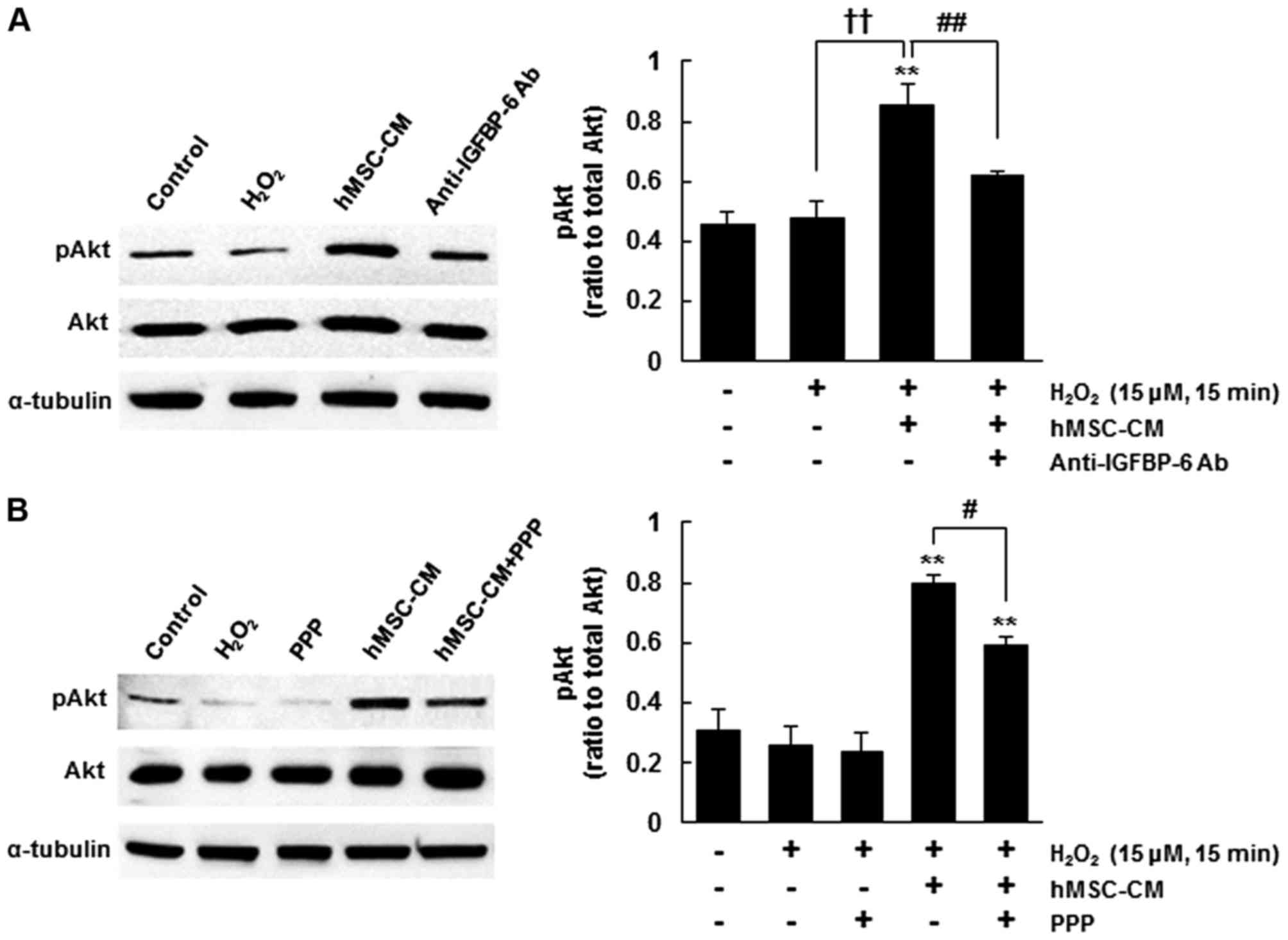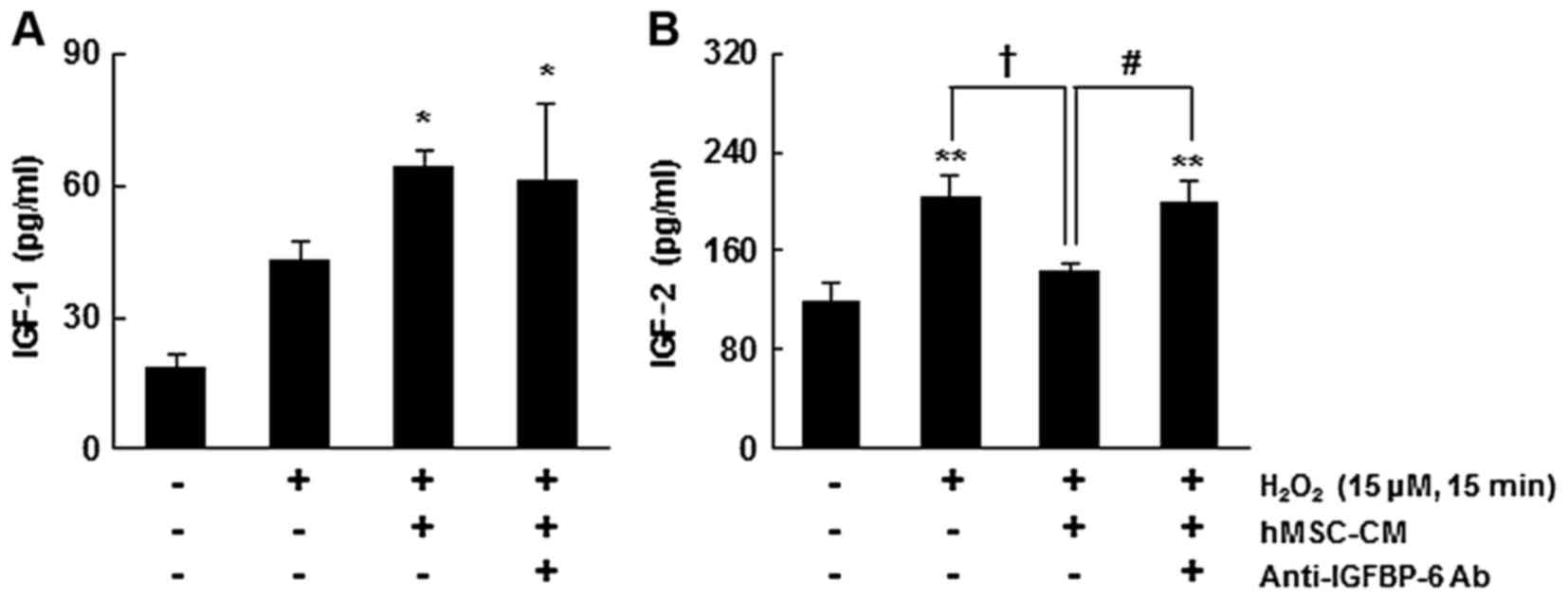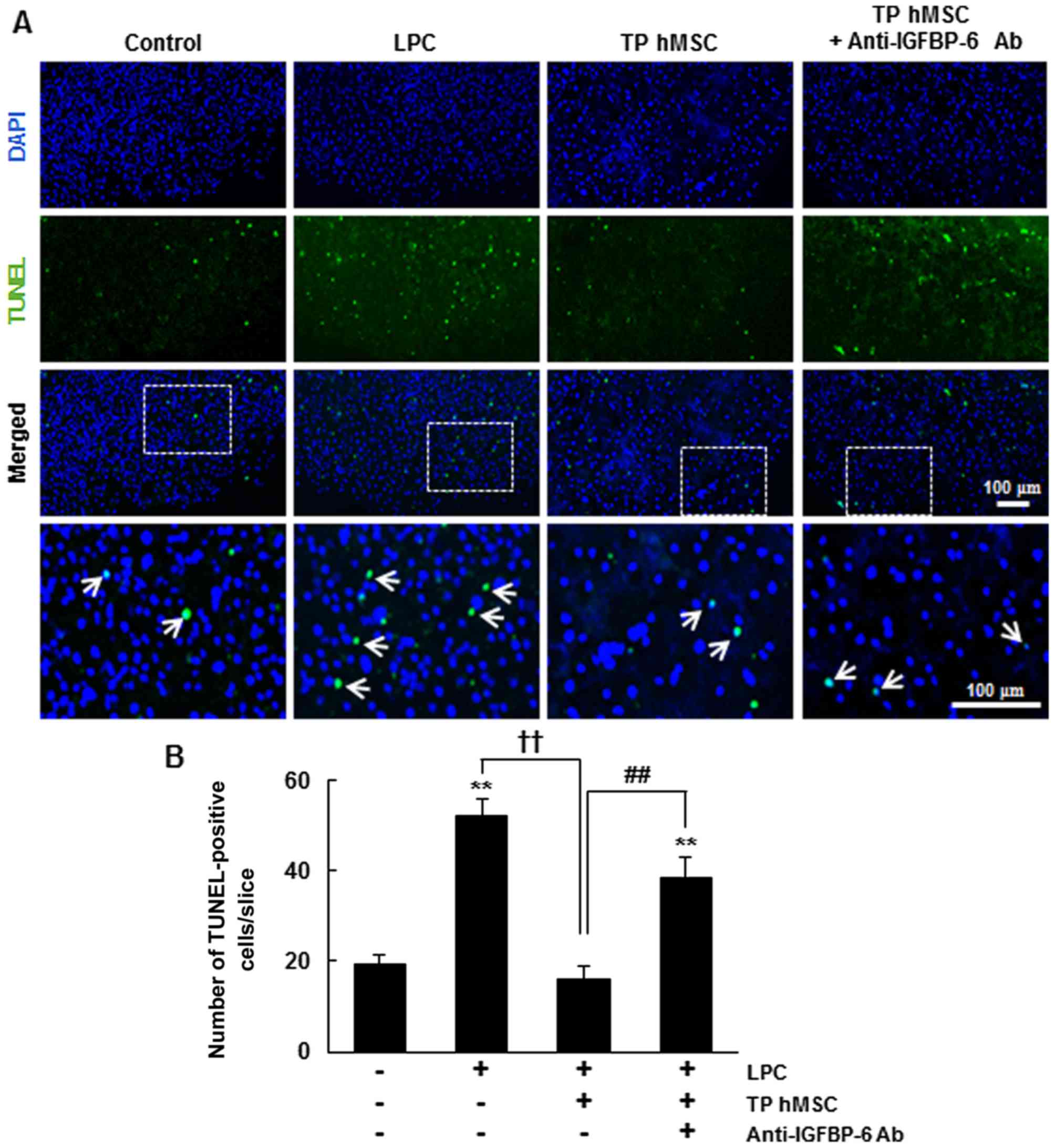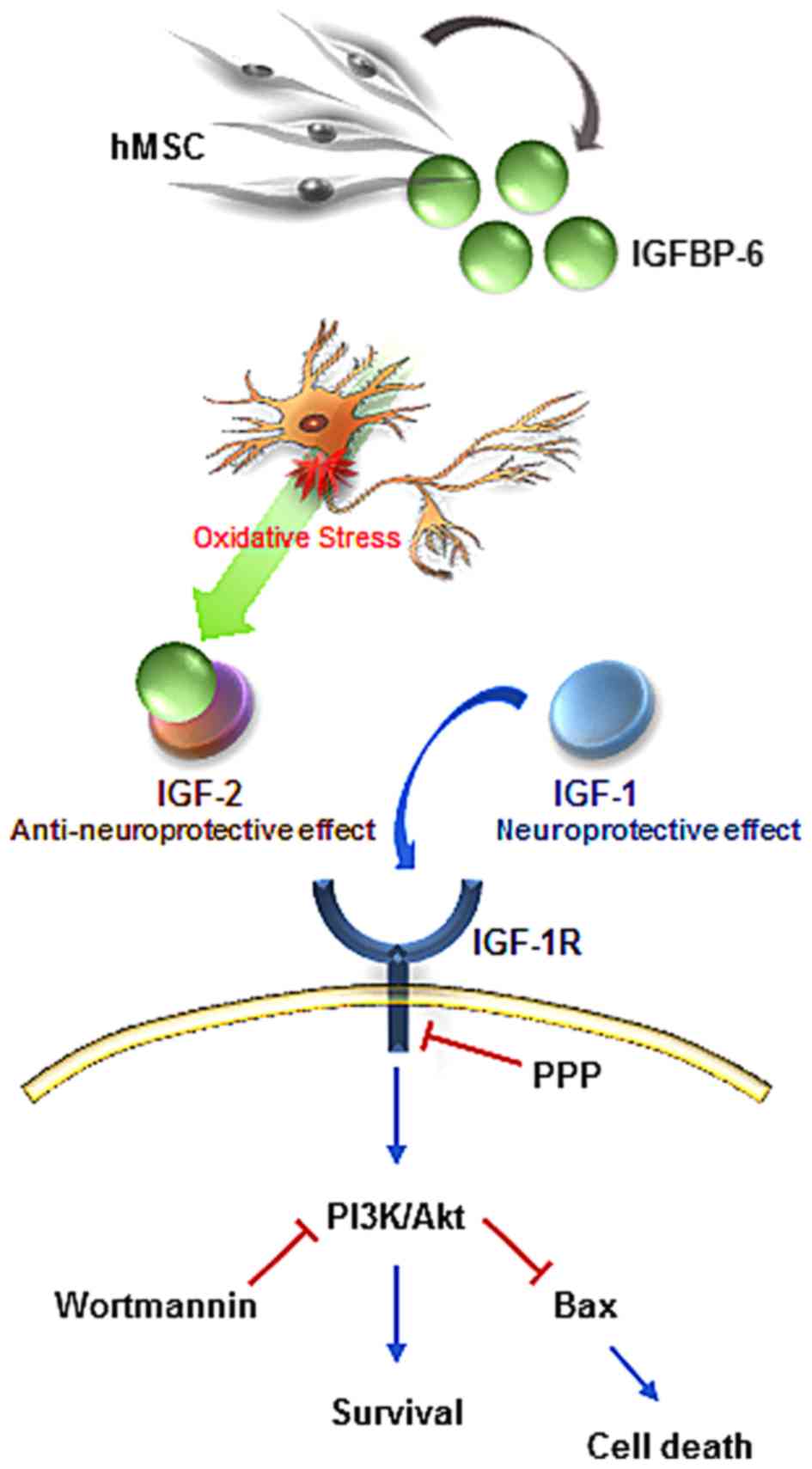|
1
|
Reynolds A, Laurie C, Mosley RL and
Gendelman HE: Oxidative stress and the pathogenesis of
neurodegenerative disorders. Int Rev Neurobiol. 82:297–325. 2007.
View Article : Google Scholar : PubMed/NCBI
|
|
2
|
Uttara B, Singh AV, Zamboni P and Mahajan
RT: Oxidative stress and neurodegenerative diseases: A review of
upstream and downstream antioxidant therapeutic options. Curr
Neuropharmacol. 7:65–74. 2009. View Article : Google Scholar : PubMed/NCBI
|
|
3
|
Uccelli A, Moretta L and Pistoia V:
Mesenchymal stem cells in health and disease. Nat Rev Immunol.
8:726–736. 2008. View
Article : Google Scholar
|
|
4
|
Mezey E: The therapeutic potential of bone
marrow-derived stromal cells. J Cell Biochem. 112:2683–2687. 2011.
View Article : Google Scholar : PubMed/NCBI
|
|
5
|
Park HW, Lim MJ, Jung H, Lee SP, Paik KS
and Chang MS: Human mesenchymal stem cell-derived Schwann cell-like
cells exhibit neurotrophic effects, via distinct growth factor
production, in a model of spinal cord injury. Glia. 58:1118–1132.
2010. View Article : Google Scholar : PubMed/NCBI
|
|
6
|
Firth SM and Baxter RC: Cellular actions
of the insulin-like growth factor binding proteins. Endocr Rev.
23:824–854. 2002. View Article : Google Scholar : PubMed/NCBI
|
|
7
|
Hwa V, Oh Y and Rosenfeld RG: The
insulin-like growth factor-binding protein (IGFBP) superfamily.
Endocr Rev. 20:761–787. 1999.PubMed/NCBI
|
|
8
|
Hoyt KR, Gallagher AJ, Hastings TG and
Reynolds IJ: Characterization of hydrogen peroxide toxicity in
cultured rat forebrain neurons. Neurochem Res. 22:333–340. 1997.
View Article : Google Scholar : PubMed/NCBI
|
|
9
|
Bach LA: Recent insights into the actions
of IGFBP-6. J Cell Commun Signal. 9:189–200. 2015. View Article : Google Scholar : PubMed/NCBI
|
|
10
|
Oskowitz A, McFerrin H, Gutschow M, Carter
ML and Pochampally R: Serum-deprived human multipotent mesenchymal
stromal cells (MSCs) are highly angiogenic. Stem Cell Res.
6:215–225. 2011. View Article : Google Scholar : PubMed/NCBI
|
|
11
|
Koike H, Ito K, Takezawa Y, Oyama T,
Yamanaka H and Suzuki K: Insulin-like growth factor binding
protein-6 inhibits prostate cancer cell proliferation: Implication
for anticancer effect of diethylstilbestrol in hormone refractory
prostate cancer. Br J Cancer. 92:1538–1544. 2005. View Article : Google Scholar : PubMed/NCBI
|
|
12
|
Cohen DM: Urea-inducible Egr-1
transcription in renal inner medullary collecting duct (mIMCD3)
cells is mediated by extracellular signal-regulated kinase
activation. Proc Natl Acad Sci USA. 93:11242–11247. 1996.
View Article : Google Scholar : PubMed/NCBI
|
|
13
|
Wu EH and Wong YH: Involvement of Gi/o
proteins in nerve growth factor-stimulated phosphorylation and
degradation of tuberin in PC-12 cells and cortical neurons. Mol
Pharmacol. 67:1195–1205. 2005. View Article : Google Scholar : PubMed/NCBI
|
|
14
|
Wahane SD, Hellbach N, Prentzell MT, Weise
SC, Vezzali R, Kreutz C, Timmer J, Krieglstein K, Thedieck K and
Vogel T: PI3K-p110-alpha-subtype signalling mediates survival,
proliferation and neurogenesis of cortical progenitor cells via
activation of mTORC2. J Neurochem. 130:255–267. 2014. View Article : Google Scholar : PubMed/NCBI
|
|
15
|
Cho JS, Park H-W, Park S-K, Roh S, Kang
SK, Paik KS and Chang MS: Transplantation of mesenchymal stem cells
enhances axonal outgrowth and cell survival in an organotypic
spinal cord slice culture. Neurosci Lett. 454:43–48. 2009.
View Article : Google Scholar : PubMed/NCBI
|
|
16
|
Saltiel AR and Kahn CR: Insulin signalling
and the regulation of glucose and lipid metabolism. Nature.
414:799–806. 2001. View
Article : Google Scholar : PubMed/NCBI
|
|
17
|
Pang Y, Zheng B, Fan LW, Rhodes PG and Cai
Z: IGF-1 protects oligodendrocyte progenitors against
TNFalpha-induced damage by activation of PI3K/Akt and interruption
of the mitochondrial apoptotic pathway. Glia. 55:1099–1107. 2007.
View Article : Google Scholar : PubMed/NCBI
|
|
18
|
Wolter KG, Hsu Y-T, Smith CL, Nechushtan
A, Xi XG and Youle RJ: Movement of Bax from the cytosol to
mitochondria during apoptosis. J Cell Biol. 139:1281–1292. 1997.
View Article : Google Scholar
|
|
19
|
Hsu YT, Wolter KG and Youle RJ:
Cytosol-to-membrane redistribution of Bax and Bcl-X(L) during
apoptosis. Proc Natl Acad Sci USA. 94:3668–3672. 1997. View Article : Google Scholar : PubMed/NCBI
|
|
20
|
Ljubisavljevic S: Oxidative stress and
neurobiology of demyelination. Mol Neurobiol. 53:744–758. 2016.
View Article : Google Scholar
|
|
21
|
Crigler L, Robey RC, Asawachaicharn A,
Gaupp D and Phinney DG: Human mesenchymal stem cell subpopulations
express a variety of neuro-regulatory molecules and promote
neuronal cell survival and neuritogenesis. Exp Neurol. 198:54–64.
2006. View Article : Google Scholar
|
|
22
|
Nakano N, Nakai Y, Seo T-B, Yamada Y, Ohno
T, Yamanaka A, Nagai Y, Fukushima M, Suzuki Y, Nakatani T, et al:
Characterization of conditioned medium of cultured bone marrow
stromal cells. Neurosci Lett. 483:57–61. 2010. View Article : Google Scholar : PubMed/NCBI
|
|
23
|
Micutkova L, Diener T, Li C,
Rogowska-Wrzesinska A, Mueck C, Huetter E, Weinberger B,
Grubeck-Loebenstein B, Roepstorff P, Zeng R, et al: Insulin-like
growth factor binding protein-6 delays replicative senescence of
human fibroblasts. Mech Ageing Dev. 132:468–479. 2011. View Article : Google Scholar : PubMed/NCBI
|
|
24
|
Schmid C, Keller C, Gosteli-Peter M and
Zapf J: Mitogenic and antiapoptotic effects of insulin-like growth
factor binding protein-6 in the human osteoblastic osteosarcoma
cell line Saos-2/B-10. Biochem Biophys Res Commun. 263:786–789.
1999. View Article : Google Scholar : PubMed/NCBI
|
|
25
|
Brunet A, Datta SR and Greenberg ME:
Transcription-dependent and -independent control of neuronal
survival by the PI3K-Akt signaling pathway. Curr Opin Neurobiol.
11:297–305. 2001. View Article : Google Scholar : PubMed/NCBI
|
|
26
|
Yamaguchi A, Tamatani M, Matsuzaki H,
Namikawa K, Kiyama H, Vitek MP, Mitsuda N and Tohyama M: Akt
activation protects hippocampal neurons from apoptosis by
inhibiting transcriptional activity of p53. J Biol Chem.
276:5256–5264. 2001. View Article : Google Scholar
|
|
27
|
Beilharz EJ, Russo VC, Butler G, Baker NL,
Connor B, Sirimanne ES, Dragunow M, Werther GA, Gluckman PD,
Williams CE, et al: Co-ordinated and cellular specific induction of
the components of the IGF/IGFBP axis in the rat brain following
hypoxic-ischemic injury. Brain Res Mol Brain Res. 59:119–134. 1998.
View Article : Google Scholar : PubMed/NCBI
|
|
28
|
Guan J, Williams CE, Skinner SJ, Mallard
EC and Gluckman PD: The effects of insulin-like growth factor
(IGF)-1, IGF-2, and des-IGF-1 on neuronal loss after
hypoxic-ischemic brain injury in adult rats: Evidence for a role
for IGF binding proteins. Endocrinology. 137:893–898. 1996.
View Article : Google Scholar : PubMed/NCBI
|
|
29
|
Chesik D, De Keyser J and Wilczak N:
Insulin-like growth factor binding protein-2 as a regulator of IGF
actions in CNS: Implications in multiple sclerosis. Cytokine Growth
Factor Rev. 18:267–278. 2007. View Article : Google Scholar : PubMed/NCBI
|
|
30
|
LeRoith D, Werner H, Beitner-Johnson D and
Roberts CT Jr: Molecular and cellular aspects of the insulin-like
growth factor I receptor. Endocr Rev. 16:143–163. 1995. View Article : Google Scholar : PubMed/NCBI
|
|
31
|
Yoon JW, Kita Y, Frank DJ, Majewski RR,
Konicek BA, Nobrega MA, Jacob H, Walterhouse D and Iannaccone P:
Gene expression profiling leads to identification of GLI1 binding
elements in target genes and a role for multiple downstream
pathways in GLI1 induced cell transformation. J Biol Chem.
277:5548–5555. 2002. View Article : Google Scholar
|
|
32
|
Xu XF, Guo C-Y, Liu J, Yang WJ, Xia YJ, Xu
L, Yu YC and Wang XP: Gli1 maintains cell survival by up-regulating
IGFBP6 and Bcl-2 through promoter regions in parallel manner in
pancreatic cancer cells. J Carcinog. 8:132009. View Article : Google Scholar : PubMed/NCBI
|
|
33
|
Agarwal NK, Qu C, Kunkalla K, Liu Y and
Vega F: Transcriptional regulation of serine/threonine protein
kinase (AKT) genes by glioma-associated oncogene homolog 1. J Biol
Chem. 288:15390–15401. 2013. View Article : Google Scholar : PubMed/NCBI
|
|
34
|
Duan C and Xu Q: Roles of insulin-like
growth factor (IGF) binding proteins in regulating IGF actions. Gen
Comp Endocrinol. 142:44–52. 2005. View Article : Google Scholar : PubMed/NCBI
|



